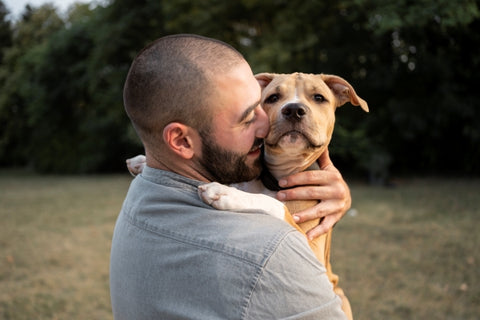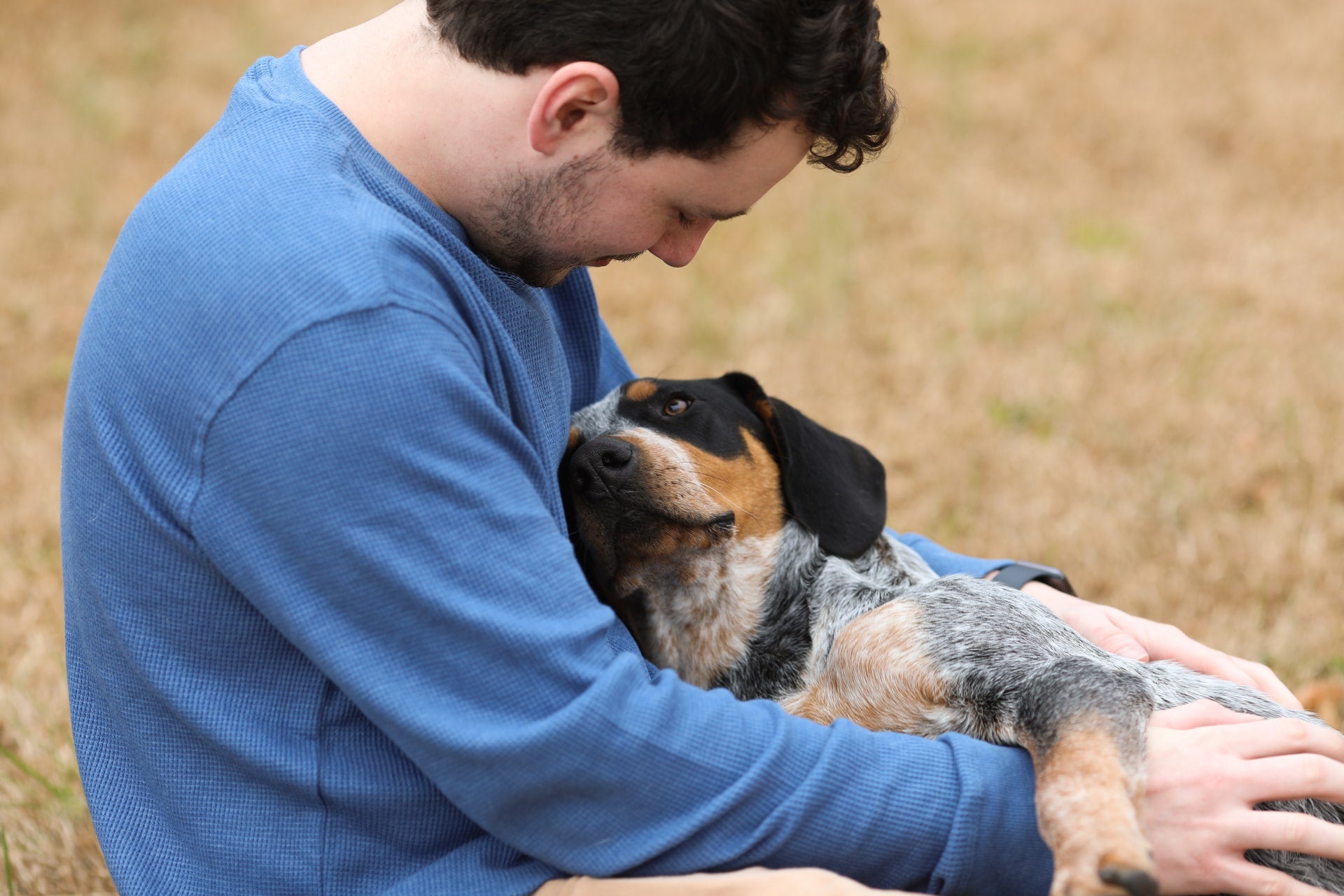Loyalty is a valued trait in dogs, but is your pup seeming a bit… too obsessed with you? If Fido refuses to leave your side and feels distressed whenever you’re gone, you may have what’s known as a “velcro dog.”
Velcro dogs are common in certain dog breeds, but can also be found in any type of breed. While your dog’s clinginess can feel flattering and endearing, it can also be frustrating and concerning for pet parents. To help you better understand why Fido is so clingy and how to modify the behavior, let’s explore some of the common reasons for velcro dog syndrome.

What is a Velcro Dog?
A velcro dog is a term used to describe dogs who are overly attached and clingy with their owners. Velcro dogs usually follow their owners from room to room, refuse to leave them alone, and become anxious when separated. Common signs of velcro dog behavior include:
- Excessive barking or whining when left alone
- Constant attention-seeking behavior
- Following owners around the house
- Inability to be left alone in a room
- Pawing, licking, and jumping on owners
- Jealousy of other animals or people
Many dogs who exhibit a sudden clingy behavior may have developed separation anxiety, which can be caused by several different triggers. Let’s take a closer look at some of the most common reasons for velcro dog behavior.

Reasons for Separation Anxiety or Velcro Behavior in Dogs
Dogs are pack animals, so they instinctively enjoy companionship. It’s expected that your canine craves some level of closeness with you, their pet parent—dogs are man’s best friend, after all—but your canine companion shouldn’t be sticking to your side at all times. While certain breeds are known for their clingy behavior such as German Shepherds, Labrador Retrievers, Golden Retrievers, and French Bulldogs, any breed can develop velcro behavior.
If your dog follow you around and just won’t leave you alone, his behavior may be due to:

Stress/Anxiety
Your pooch trusts you, and his clinginess may be his way of seeking stability during times of stress, such as changes in routine or being in an unfamiliar setting. Apart from change in routine, a dog can develop separation anxiety due to isolation or when their owners move away.
Did you know that pets can pick up on our emotions, too? If you’re stressed or anxious, your dog may also start to feel the same way. Similarly, if he’s not sure how to react in a situation, he’ll look at you as a guide.
Separation anxiety can also cause clinginess, especially when you’re right about to leave the house. It’s worth noting though that separation anxiety is a bit different from general clinginess. A dog with separation anxiety is typically more anxious and distressed when left alone, whereas a dog's clingy behavior is usually more linked to his need for companionship.
Health Issues
If your dog is feeling vulnerable, he may stay close to you for an added sense of security. Clinginess is especially common in senior dogs, especially when losing vision or hearing. As your dog’s world becomes less familiar, he’ll stay close to you as a source of comfort and familiarity. Canine cognitive dysfunction starts to show signs in old dogs, causing your pup to become more clingy. So, check your dog's age and health condition if his clingy behavior is sudden.
And if you believe that your dog’s clinginess is due to a health issue, make sure to talk to your vet as soon as possible.
Bad Habits
Sometimes, clinginess is simply a learned behavior or a bad habit that your dog needs to unlearn. For example, if his clinginess is often rewarded with treats and cuddles, why would he want to change his behavior? If this has become a destructive behavior, it’s a good idea to start slowly ignoring him when he exhibits it. This means offering no verbal/ physical response and eventually, your pup will realize his clinginess isn’t effective in getting the attention he craves.
Positive reinforcement training is also an effective way to help your pooch learn new behaviors. To do this, reward your pup with treats and praises when he exhibits the desired behaviors, such as sitting down next to you instead of pawing on you.
Inadequate Socialization
Your dog could also become clingy if he isn’t properly socialized, or if you take him everywhere with you. It’s important that he learns how to be comfortable and confident both on his own and with other people and pets.
If you’re looking to help your dog become more independent, it’s important that he learns how to be comfortable on his own. Let him roam around the house and yard without you following him, this will help build his confidence and independence. It’s also beneficial to expose your pup to different people, animals, and situations. This can help him become more comfortable in different environments, which will (in turn) make your dog less clingy.
FOMO/Curiosity
Some dogs simply don’t want to miss out on any potential fun—even if you’re just getting up to use the bathroom! This is especially common in dogs who are at a young age, impressionable puppies who just want to learn from you.
Boredom or Lack of Stimulation
When we’re bored, we stick to our friends and family for comfort. The same goes for dogs; if your dog is not given enough mental stimulation, he may find solace in sticking around you.
Make sure that your pup gets plenty of physical activity throughout the day—this will help tire him out. Interactive toys such as puzzle toys, chew toys, and treat-dispensing toys can help keep your pup occupied when he’s alone.
Mating Season
A female dog may also become clingy if she’s in heat and looking for a mate. During this time, she will look for a suitable partner and can become clingier towards the people in her life. It’s important to note that if you have an intact pup, it's best to keep him away from male dogs when she is in heat to avoid any unwanted pregnancies.
Clingy Dog Breeds
Some are just clingy dogs by nature. Breeds like the Shih tzu, Poodle, Yorkshire Terrier, and Maltese are some of the most clingy breeds because they’re highly social and crave companionship. Lapdogs tend to be particularly clingy, longing for physical contact and attention from their humans throughout the day.
Mixed breed dogs may also exhibit clingy behavior, as all dogs have their own unique personalities. It’s important to be aware of your dog's tendencies and what he needs to feel secure and safe.
No matter why your pup is clingy or how he expresses it, understanding why our dogs become so needy is the first step to helping him get over the separation anxiety. As pet parents, it’s important that we stay patient and consistent in our training and provide enough love and attention to our pups so they won’t feel the urge to be clingy.

How to Help Your Clingy Dog Be Less Clingy
Even if you love your dog’s extreme closeness, excessive clingy behavior isn’t good for his well-being. You want your dog to be confident and independent; time spent with you should be fun and enjoyable, but not absolutely necessary at all times for your dog to feel comfortable.
How you help your dog become less clingy depends on the reason behind his clinginess, similar to cats when they become clingy. For example, if his behavior is a result of a health issue, then of course, more training isn’t going to resolve the issue. However, if it’s due to inadequate socialization or boredom, then there are some steps you can take to help your pup become less clingy:
- Talk to your vet to address any underlying health issues.
- Make sure your dog is getting plenty of exercise. If you wear him out, he’s bound to be less interested in following you around!
- Keep your dog busy and entertained with more mental stimulation.
- Give your dog a designated space (crate training, for example) where he can feel comfortable and confident being alone.
- Desensitize your dog to your movements so he doesn’t react every time you get up or grab your keys. For example, go into the kitchen (or wherever his food bowl is) and start cleaning the kitchen rather than filling his bowl, or grab your keys and then turn on the TV. That way, he’ll eventually learn that he doesn’t need to get up or even react every time.
Clingy Dog Conclusion
Sometimes, new clingy behavior is simply a request for attention. If your dog has recently started clinging to your side, do a quick check to make sure he’s not trying to tell you something. For example, check that there’s nothing stuck in his paw or that you remembered to feed him, and see if that resolves the issue.
Additionally, try to keep your home environment as calm and stress-free as possible to reduce separation anxiety. For pups who are prone to anxious behavior, PetHonesty’s Premium Hemp Calming Chews feature naturally calming ingredients such as melatonin, chamomile, and valerian root to reduce stress and anxiety.














